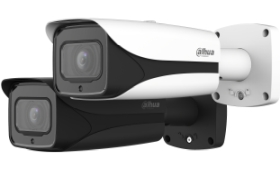

IP67 rating: Looking at the IP rating on cameras is the simplest way to tell if a camera can handle outdoor environments. A camera with IP65, IP66, IP67, or IP68 rating means the camera offers full protection against dust, and varying degrees of water resistance ranging from a water jet (IP65) up to 1 m of water submersion (IP68). Most of Dahua’s cameras offer an outdoor rating of IP67.
Even with outdoor IP ratings on cameras, using incorrect mounts or mounting techniques can cause the camera’s outdoor design to become ineffective. Ensure that proper mounts are used and a drip loop is installed to prevent any water from finding its way into the outdoor conduit and components. This should be done in any outdoor application, whether or not water is a primary concern.
Temperature ratings: While a camera may be outdoor rated for water and dust, that doesn’t automatically qualify it for all outdoor temperature applications. Check Dahua’s temperature ratings on specific cameras and make it a point to note the temperature range on each camera to ensure it meets your deployment’s specific needs. While many of Dahua’s outdoor rated cameras are able to perform in temperatures down to -30°C, for extremely cold climates a temperature rating of -72°C is recommended.
It is also important to note that even those cameras designed for outdoor use will usually need to be installed in weather resistant housing and may even require a heater to stabilise the temperature inside the housing in the event of extreme cold.
Heating elements: For particularly cold applications, it is best to look for cameras with built-in heaters. This feature allows cameras to withstand more extreme winter temperatures. It is important to note that cameras with built-in heaters will require additional power compared to cameras without a heater.
Wiper blades: For outdoor environments that are plagued by rain, snow or fog and require high-powered PTZs that can capture distant details, look for built-in wiper blades. This small feature ensures that the lens of the camera is clear of water and other debris, so that video is usable no matter the weather conditions.
Voltage tolerance: The final requirement may seem like a strange one, but voltage protection is an important yet often overlooked spec for outdoor cameras. Many Dahua cameras can handle a 25% change in voltage coming into the camera, which is important for outdoor deployments as environmental conditions can easily affect a power source. For more advanced protection, specific lightning protected cameras can be found with up to an 8 kV surge protection rating.
Selecting the best camera and mounts for your outdoor location, as well as using preventative installation techniques, can help prevent future issues and save time for your business.
| Tel: | +27 10 593 3242 |
| Email: | [email protected] |
| www: | www.dahuasecurity.com/sa |
| Articles: | More information and articles about Dahua Technology South Africa |

© Technews Publishing (Pty) Ltd. | All Rights Reserved.